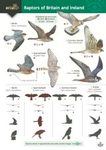"[...] I strongly recommend this book to all with a particular interest in Merlins and raptors in general. It has much to offer those with a general interest in birds."
– Trevor Smith, Ibis 163(1), January 2021
"Like its companion volume (The Common Kestrel) it is a very comprehensive study of our smallest falcon, and also covers its entire range and draws upon years of academic ornithological study. Despite being a detailed scientific monograph, it is accessible and will be of interest to even a casual birder as well as a raptor specialist (although some will baulk at the hefty price). One reason it is so accessible is the use of very good images, both photographic and drawn. The author’s background in a completely different scientific tradition, from physics and aerodynamics gives him a unique perspective and is another reason it is so accessible. He has become a raptor specialist through studying the physics of their flight so combines scientific rigour with the amateur birder’s delight in birds. Rarely has such a combination resulted in an iconic monograph."
– Fatbirder
"[...] Sorry, Merlins, I was remiss to neglect you. The Merlin reveals a fascinating bird, as well as an interesting look at the studies that have shed light on it. It is required for anyone working with this falcon, and recommended to other ornithologists, as well as birders and falconers who’d like to know more about it."
– Grant McCreary (20-10-2015), read the full review at The Birder's Library
"[...] this is a very good book [...] All in all, this is a book that all raptor enthusiasts and Merlin workers especially will want to have on their shelves."
– Eric Meek, Ibis 157, 2015
"The raptors have probably attracted more monographs than any other group of birds, with most of the British and Irish species having at least one volume written about them. The Merlin, by Richard Sale, is the first to tackle this small falcon since Petere Wright's book on the Merlins of the South-East Yorkshire Dales, published nearly a decade ago. Some readers will recognise Richard's name from the Poyser monograph on Gyrfalcon, written in partnership with Eugene Potapov, and like that book, this is a detailed and well-researched account.
The book follows what has become a fairly standard format for monographs. The species and its character are first introduced through a more general section on falcons – and in this instance falconry – before the text turns to diet and hunting behaviour. Roughly a quarter of the book is then devoted to breeding ecology which, given that this is where most research on the species has been focused, is extremely rich in its content. The final third of the book covers movements, mortality, interactions with other species and the reasons for population change.
The focus of the book is very much global, placing the ecology and behaviour of British and Irish Merlins into a wider context, but Richard has also been able to bring to the book the research being carried by fieldworkers here, working in places like the Peak District and Scotland. It is really good to see, for example, the chick growth curves produced by the work of Nick Picozzi, Ian Poxton and Alan Heavisides in a book of this kind.
The text is packed with information and is well-supported by the key references but there are occasions where long and poorly structured sentences make it difficult to interpret what is being said. At a wider level the narrative lacks structure and the reader isn't engaged in a 'story' in the way that the best raptor monographs manage to achieve. Photographs and other figures accompany the text, with the latter mostly well used to support what is being said."
– Mike Toms, BTO book reviews






























